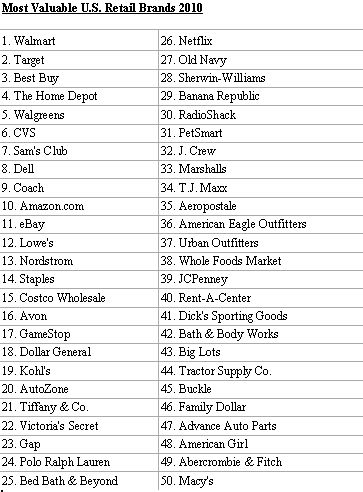Wal-Mart, Target Named Most Valuable Retail Brands
March 17, 2010 - Retail brand consultants Interbrand Design Forum released the Most Valuable U.S. Retail Brands report, the second ranking of the top 50 retail brands. Wal-Mart claimed top honors as the most valuable retail brand, followed by Target (No. 2), Best Buy (No. 3), The Home Depot (No. 4) and Walgreens (No. 5).
The most striking shift in this year's ranking is that despite the weakened economy, the Top 25 companies grew their brands' value over last year. They not only survived, they prospered. However, the next 25 as a group lost value.
The most striking shift in this year's ranking is that despite the weakened economy, the Top 25 companies grew their brands' value over last year. They not only survived, they prospered. However, the next 25 as a group lost value.
 Broadly speaking, falling companies slashed prices, lost focus and chose not to renew their brand through investment or innovation. Rising companies had their brand proposition fully in place to take advantage of the downturn, invested in brand and convinced the customer of their relevance and worth.
Broadly speaking, falling companies slashed prices, lost focus and chose not to renew their brand through investment or innovation. Rising companies had their brand proposition fully in place to take advantage of the downturn, invested in brand and convinced the customer of their relevance and worth.This is Wal-Mart's second year as the top U.S. retail brand, however the big news is how much the brand value has increased. The economic downturn made it relevant to an even greater number of shoppers and its store remodel program "Project Impact" -- less inventory, wider aisles, lack of in-aisle displays -- paid off in high same-store sales. Wal-Mart grew its brand value by 19 percent, or $25 billion, to $154 billion. It continues to be the most valuable retail brand in the world.
Target is another company that built brand value this year. With a 49 percent increase, Target leapfrogged Best Buy and The Home Depot to take the No. 2 spot on the list. As a brand-led company, Target focused on improving its operations to boost performance in the face of reduced growth without compromising brand. The company streamlined its assets, according to what matters most to the Target customer.
Five brands are new to the list in 2010:
- Dollar General (No.18) -- new to the list after going public in 2009
- Buckle (No. 45)
- Family Dollar (No.46)
- Advance Auto Parts (No. 47)
- Macy's (No. 50)
- Dollar General (No.18) -- new to the list after going public in 2009
- Buckle (No. 45)
- Family Dollar (No.46)
- Advance Auto Parts (No. 47)
- Macy's (No. 50)
A highlight among those new to the list is Macy's, whose debut is attributable to its three-year focus on becoming a "master brand." By holding steady to its strategic direction, it has succeeded in capitalizing on brand to improve its financials, and the results are showing up in organic sales growth in its 850 stores. Macy's now has the clarity and power of a national brand.
The five brands that fell out of the top 50 are:
- Hollister (last year No. 40)
- Barnes & Noble (last year No. 44)
- Men's Wearhouse (last year No. 45)
- Gymboree (last year No. 48)
- Anthropologie (last year No. 50)
In turbulent times, brands that lack a solid brand strategy are likely to lose value along with the ability to drive demand. While many companies engage in tactical brand efforts, there are relatively few that filter their business strategy through their brand strategy to guide decisions. The tough market demands differentiation, innovation and value-add like never before, so brands need to be clear and compelling to stand out from price-based competition.
To qualify for inclusion in the Interbrand Design Forum Most Valuable U.S. Retail Brands, each company must be a market-facing brand, operate significant distribution channels in the United States, with publicly available financial data and positive Economic Value Added. Interbrand examines brands through the lens of financial strength, importance in driving consumer selection and the likelihood of ongoing branded revenue. This methodology evaluates brand value in the same way any other corporate asset is valued -- on the basis of how much it is likely to earn for the company in the future.
You can access Interbrand Design Forum's Most Valuable U.S. Retail Brands report online at www.interbranddesignforum.com.
